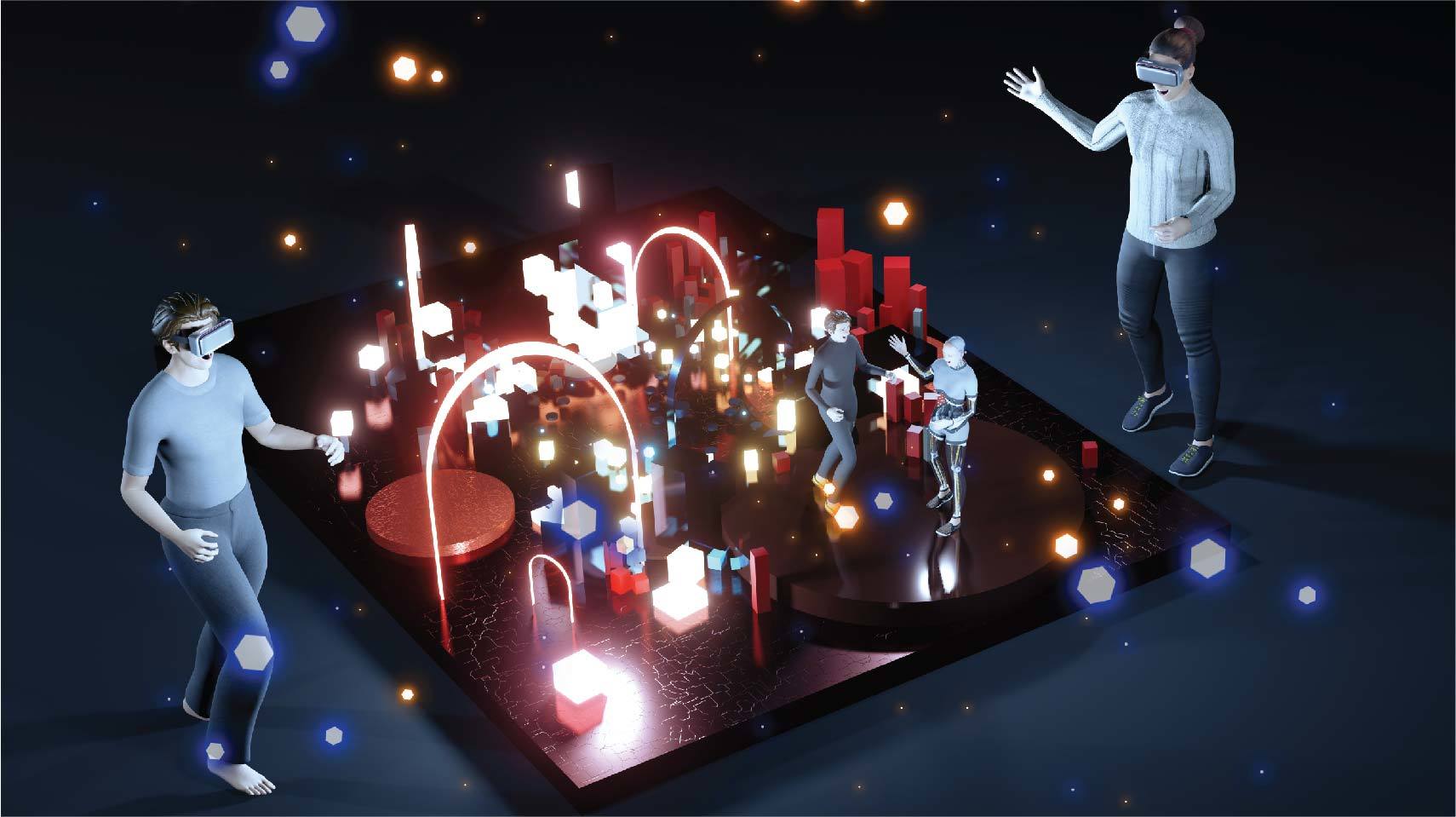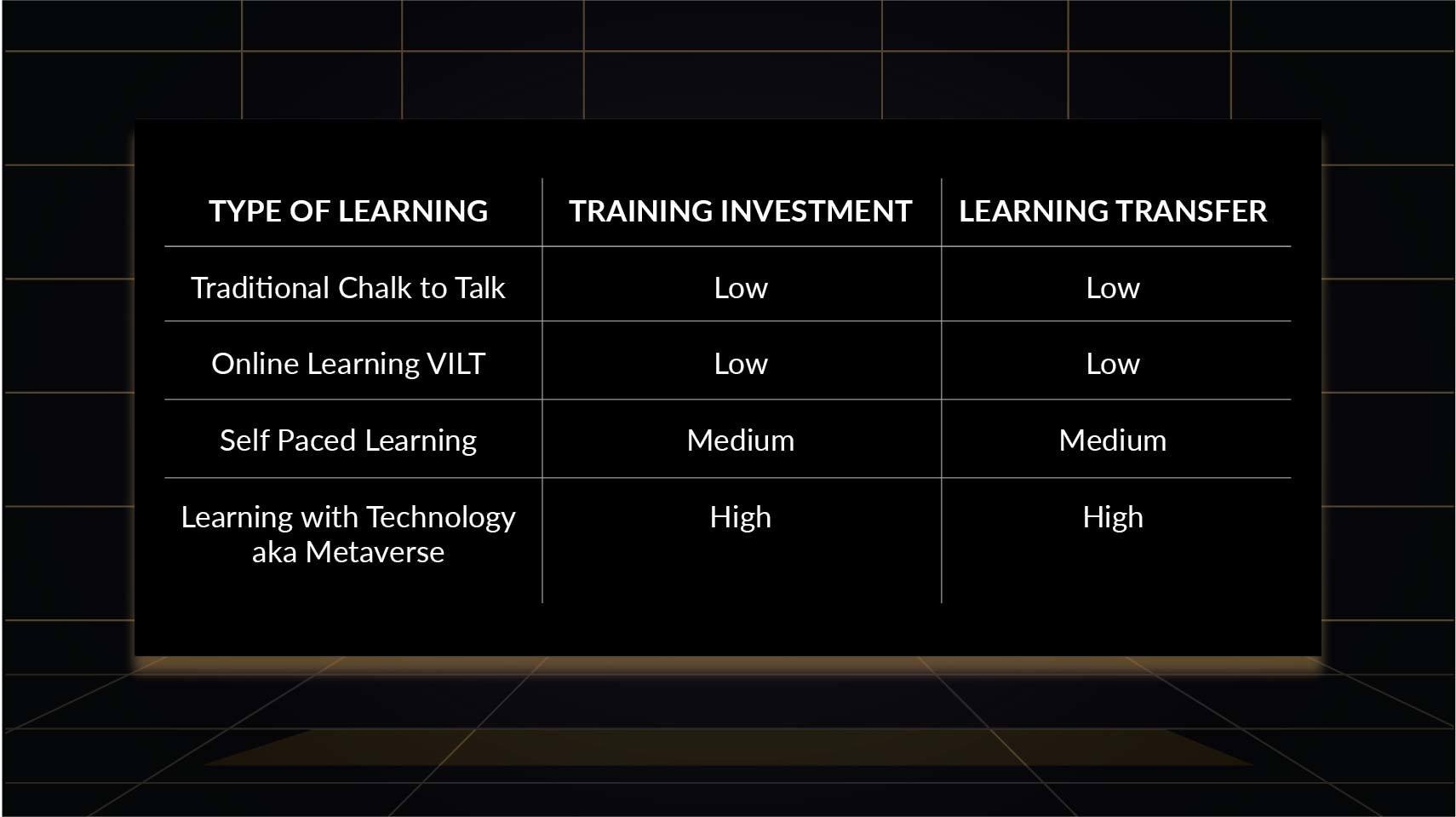The metaverse is happening. It will soon be as omnipresent as Instagram, Meta and TikTok. Technology will advance to bring us new immersive worlds. How our learning ecosystems prepare must also advance to meet these new opportunities.
The Vision
Imagine a rectangular training room, surrounded by whiteboards, presentation screens, and movable chairs. You’re taking your new joiners on the growth journey of the organization. All of a sudden, a timeline is projected onto the middle of the floor. Employees move their chairs away to stand up in the present, ready to move backward and enter the year 1980—a year in which they will encounter a new reality. Everything that surrounds them is from that year. Who’s that young, charming, driven person they see in the metaverse? Well, that’s the organization’s CEO when he was 22 years old! The employees explore, they ask questions, they ponder, and they learn!

This deep, transferable learning, that will last a lifetime, comes to us by virtue of the metaverse being delivered in a hybrid, guided-play environment that represents the learning of the future. The metaverse opens the door to new possibilities and incredible ways of leveraging learning solutions within a greater ecosystem. A digital world in which users can collaborate, interact, analyze, practice, and problem-solve is ideal for corporate Learning and Development (L&D) because it gives learners the tools they need to succeed while at the same time, encouraging and enabling them to manage their own learning experience.
2022 has already ushered in widespread investment in Learning and Development programs and technology, specifically to engage a new workforce and enhance employee experiences. The metaverse, on the other hand, continues to be the talking point in the news, and organizations are starting to implement learning interactions in virtual environments. Consumers, especially Gen Z, expect personalized, engaging experiences in their day-to-day life and that is setting the standard for learning solutions.
As the metaverse gets underway, businesses, L&D professionals, Instructional Designers, and other learning solution providers have a chance to pave the way rather than getting caught up in the whirlpool. In this article, we offer a path for bringing the best learning practices into the metaverse. We suggest a series of tried and tested principles to guide the design of new learning technology. The metaverse is likely to completely support Augmented Reality (AR) and Virtual Reality (VR) technologies, combined with Artificial Intelligence (AI). The metaverse, in its most optimal state, will allow anyone to create content on a global, interoperable platform where they can share their content and games with the world.
How To Embrace Digital Disruption To Adapt To The Multiverse
Learning is ambient. It is the job of the L&D team to meet the learner in a place that they’re comfortable in and familiar with, and more importantly, a place that facilitates the transfer of knowledge. Figuring out learner behaviors in a comfortable environment will help identify roadblocks, and therefore, opportunities where the overall learner experience can be improved. You can begin by asking the following questions:
- How are your employees acquiring the information they need?
- Where do your employees access learning resources?
- What captures your employees’ attention when they learn?
- How do you provide employees with feedback?
Once you have these answers in place, it comes down to enabling the employee to find what they need, when they need it. Instead of engaging in a traditional learning journey, embrace the chaos. After which, you make the required information available through a combination of new technologies—online chatbots for support, AR to run practice simulations, or even VR-led fully immersive sessions. With progressive technologies, and advancing learning cultures that accept remote learning and other digital disruptions, now is the best time to start formulating your organization’s Learning and Development strategy for the metaverse.
The Real ROI
Organizations want their employees to come out of their training programs able to seamlessly perform their jobs in real life. That is the best way to measure whether your training was successful or not.

What Type Of Training Can The Metaverse Be Best Used For?
Experiential learning technologies, including AR, VR, and other 3D simulations give learners a controlled and safe place to practice otherwise dangerous tasks. It isn’t necessary for all experiences to be driven through new-age technologies. Despite the fact that it makes all training fun and engaging, focus on using it for the “right” experiences.
- Reducing risk in dangerous tasks
It is safe to operate any machinery incorrectly in Virtual Reality. In fields like construction, law enforcement, safety training, health care, and manufacturing, “mistakes” are often life-threatening—not to mention expensive. Immersive simulations would help reduce the number of botched operations. VR can accurately replicate tasks and procedures and this could provide practical and hands-on training to enable learners to visualize, practice, and prepare. - Prepare and practice soft skills
High-risk industries aren’t the only ones that could benefit from experiential learning. The metaverse could give learners the opportunity to practice their soft skills uninhibitedly and identify their shortcomings. Think of customer service professionals who could practice de-escalating conversations with customers, and interact with heated exchanges while having actually prepared for those exchanges. Imagine a multiple scenarios sales negotiation simulation that could better train your sales personnel.
And so, we return to the classroom surrounded by whiteboards that can transport learners as if they work in a magic room. In this room and in this world, employees will have first-hand experiences, master a broader suite of skills, and be better equipped to transfer what they learn to their real work. The metaverse is coming to businesses. The question is whether learning solution providers, designers, policymakers, business owners, and employees can appropriately use it to enhance learning experiences.
Quelle:
Foto: naratrip/Shutterstock
